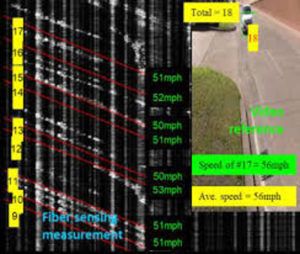USA-based multinational telecommunications company Verizon has used optical sensor technology developed by Japanese electronics company NEC to collect intelligent traffic monitoring information from non-purpose-built fiber cabling already in the ground.
In a recent proof-of-concept field trial, Verizon and NEC were able to use network infrastructure with existing pre-laid fiber optic cables as distributed optical sensors to collect information on city traffic patterns, road conditions, road capacity, and vehicle classification information, including the measurement of vehicle density, direction, speed, acceleration, deceleration and more. The trial used new optical sensor technology developed by NEC with software underpinned by artificial intelligence (AI) for intelligent traffic monitoring. Historically, companies have had to lay purpose-built fiber very shallow in the ground with fiber grating at pre-determined intervals to gather and synthesize this type of information. Now, with NEC’s new optical sensor technology, Verizon is able to use existing non-purpose-built fiber to generate similar data.
 This new technology could lead to or improve other solutions that support public functions such as helping first responders detect and respond to gun shots and enhancing municipalities’ ability to more quickly and efficiently identify earlier deterioration of bridges, tunnels and other infrastructure. There is a substantial breadth of geography where municipalities can mine for this new data. Verizon is uniquely positioned to be able to scale this solution across the USA as it already has hundreds of thousands of miles of fiber in place and plans to deploy 1,400 miles (2,253km) of additional fiber per month.
This new technology could lead to or improve other solutions that support public functions such as helping first responders detect and respond to gun shots and enhancing municipalities’ ability to more quickly and efficiently identify earlier deterioration of bridges, tunnels and other infrastructure. There is a substantial breadth of geography where municipalities can mine for this new data. Verizon is uniquely positioned to be able to scale this solution across the USA as it already has hundreds of thousands of miles of fiber in place and plans to deploy 1,400 miles (2,253km) of additional fiber per month.
The trials were accomplished through a fiber sensing system that coexisted with existing Wavelength Division Multiplexing (WDM) communication channels on the same fiber with minimal impact to data communication capacity, making it suitable for deployment even in traffic congested networks. This marks the first time that a 36.8Tb/s data transmission system and distributed optical fiber sensing have been successfully demonstrated together through an operational telecom network. It was also the first time and longest distance that such sensing data has been collected through a working fiber telecom network.
 AI tools such as Convolutional Neural Networks (CNN) and Software Vector Machines were used in order to take advantage of Distributed Intelligent Traffic Informatics (DITI). Using just a single integrated interrogator, the distributed multi-parameter sensor system evaluated various properties of back-scattering light, which can be translated into actionable information over a wide range of areas previously unattainable by conventional sensors.
AI tools such as Convolutional Neural Networks (CNN) and Software Vector Machines were used in order to take advantage of Distributed Intelligent Traffic Informatics (DITI). Using just a single integrated interrogator, the distributed multi-parameter sensor system evaluated various properties of back-scattering light, which can be translated into actionable information over a wide range of areas previously unattainable by conventional sensors.
“This test marks an important milestone for technology that could provide a huge leap forward for those building smart cities and those tasked to manage them,” said Adam Koeppe, SVP of technology planning and development with Verizon. “Instead of ripping up tarmac to place road and traffic-sensing technology, cities will be able to simply piggyback our existing fiber optic network.”
Atsuo Kawamura, NEC’s executive vice president, said, “The results obtained from this joint research program with Verizon are a great advancement for smart city business opportunities, especially for safer city solutions such as the conservation of roads and the utilization of traffic information. We are confident that these cutting-edge solutions will provide meaningful new value for optical fiber networks.” 





